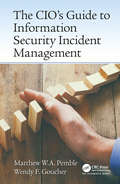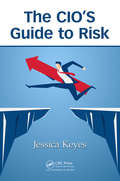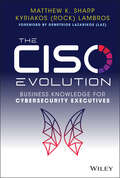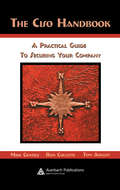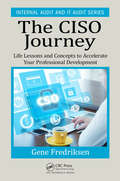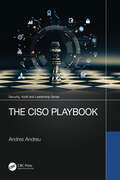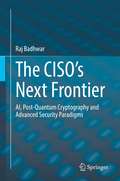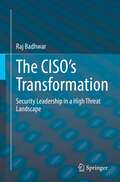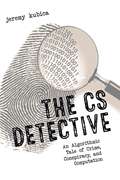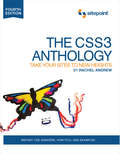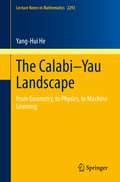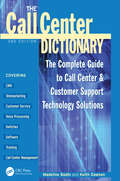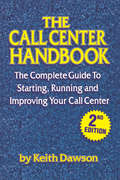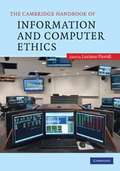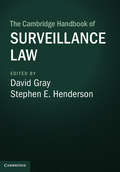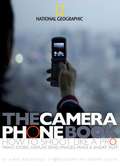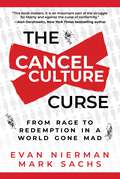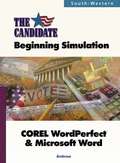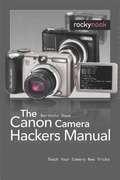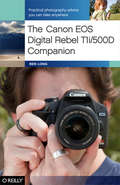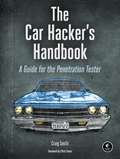- Table View
- List View
The CIO’s Guide to Information Security Incident Management
by Matthew William Pemble Wendy Fiona GoucherThis book will help IT and business operations managers who have been tasked with addressing security issues. It provides a solid understanding of security incident response and detailed guidance in the setting up and running of specialist incident management teams. Having an incident response plan is required for compliance with government regulations, industry standards such as PCI DSS, and certifications such as ISO 27001. This book will help organizations meet those compliance requirements.
The CIO’s Guide to Risk
by Jessica KeyesIn an age of globalization, widely distributed systems, and rapidly advancing technological change, IT professionals and their managers must understand that risk is ever present. The key to project success is to identify risk and subsequently deal with it. The CIO’s Guide to Risk addresses the many faces of risk, whether it be in systems development, adoption of bleeding edge tech, the push for innovation, and even the march toward all things social media. Risk management planning, risk identification, qualitative and quantitative risk analysis, contingency planning, and risk monitoring and control are all addressed on a macro as well as micro level. The book begins with a big-picture view of analyzing technology trends to evaluate risk. It shows how to conceptualize trends, analyze their effect on infrastructure, develop metrics to measure success, and assess risk in adapting new technology. The book takes an in-depth look at project-related risks. It explains the fundamentals of project management and how project management relates to systems development and technology implementation. Techniques for analyzing project risk include brainstorming, the Delphi technique, assumption analysis, and decision analysis. Metrics to track and control project risks include the Balance Scorecard, project monitoring and reporting, and business and technology metrics. The book also takes an in-depth look at the role of knowledge management and innovation management in identifying, assessing, and managing risk. The book concludes with an executive’s guide to the legal and privacy issues related to risk management, as well overviews of risks associated with social media and mobile environments. With its checklists, templates, and worksheets, the book is an indispensable reference on risk and information technology.
The CISO Evolution: Business Knowledge for Cybersecurity Executives
by Matthew K. Sharp Kyriakos LambrosLearn to effectively deliver business aligned cybersecurity outcomes In The CISO Evolution: Business Knowledge for Cybersecurity Executives, information security experts Matthew K. Sharp and Kyriakos “Rock” Lambros deliver an insightful and practical resource to help cybersecurity professionals develop the skills they need to effectively communicate with senior management and boards. They assert business aligned cybersecurity is crucial and demonstrate how business acumen is being put into action to deliver meaningful business outcomes. The authors use illustrative stories to show professionals how to establish an executive presence and avoid the most common pitfalls experienced by technology experts when speaking and presenting to executives. The book will show you how to: Inspire trust in senior business leaders by properly aligning and setting expectations around risk appetite and capital allocation Properly characterize the indispensable role of cybersecurity in your company’s overall strategic plan Acquire the necessary funding and resources for your company’s cybersecurity program and avoid the stress and anxiety that comes with underfunding Perfect for security and risk professionals, IT auditors, and risk managers looking for effective strategies to communicate cybersecurity concepts and ideas to business professionals without a background in technology. The CISO Evolution is also a must-read resource for business executives, managers, and leaders hoping to improve the quality of dialogue with their cybersecurity leaders.
The CISO Handbook: A Practical Guide to Securing Your Company
by Michael Gentile Ron Collette Thomas D. AugustTruly a practical work, this handbook offers a comprehensive roadmap for designing and implementing an effective information security program based on real world scenarios. It builds a bridge between high-level theory and practical execution by illustrating solutions to practical issues often overlooked by theoretical texts. This leads to a set of practices that security professionals can use every day. The framework it describes can be expanded or contracted to meet the needs of almost any organization. A reference as well as a guide, each of the chapters are self-contained and can be read in any order.
The CISO Journey: Life Lessons and Concepts to Accelerate Your Professional Development (Internal Audit and IT Audit)
by Eugene M FredriksenThe book takes readers though a series of security and risk discussions based on real-life experiences. While the experience story may not be technical, it will relate specifically to a value or skill critical to being a successful CISO. The core content is organized into ten major chapters, each relating to a "Rule of Information Security" developed through a career of real life experiences. The elements are selected to accelerate the development of CISO skills critical to success. Each segments clearly calls out lessons learned and skills to be developed. The last segment of the book addresses presenting security to senior execs and board members, and provides sample content and materials.
The CISO Playbook (ISSN)
by Andres AndreuA CISO is the ultimate guardian of an organization's digital assets. As a cybersecurity leader ,a CISO must possess a unique balance of executive leadership, technical knowledge, strategic vision, and effective communication skills. The ever-evolving cyberthreat landscape demands a resilient, proactive approach coupled with a keen ability to anticipate attack angles and implement protective security mechanisms. Simultaneously, a cybersecurity leader must navigate the complexities of balancing security requirements with business objectives, fostering a culture of cybersecurity awareness, and ensuring compliance with regulatory frameworks.The CISO Playbook aims to provide nothing but real-world advice and perspectives to both up-and-coming cybersecurity leaders as well as existing ones looking to grow. The book does not approach cybersecurity leadership from the perspective of the academic, or what it should be, but more from that which it really is. Moreover, it focuses on the many things a cybersecurity leader needs to “be” given that the role is dynamic and ever-evolving, requiring a high level of adaptability.A CISO's career is touched from many differing angles, by many different people and roles. A healthy selection of these entities, from executive recruiters to salespeople to venture capitalists, is included to provide real-world value to the reader. To augment these, the book covers many areas that a cybersecurity leader needs to understand, from the pre-interview stage to the first quarter and from security operations to the softer skills such as storytelling and communications.The book wraps up with a focus on techniques and knowledge areas, such as financial literacy, that are essential for a CISO to be effective. Other important areas, such as understanding the adversaries' mindset and self-preservation, are covered as well. A credo is provided as an example of the documented commitment a cybersecurity leader must make and remain true to.
The CISO’s Next Frontier: AI, Post-Quantum Cryptography and Advanced Security Paradigms
by Raj BadhwarThis book provides an advanced understanding of cyber threats as well as the risks companies are facing. It includes a detailed analysis of many technologies and approaches important to decreasing, mitigating or remediating those threats and risks. Cyber security technologies discussed in this book are futuristic and current. Advanced security topics such as secure remote work, data security, network security, application and device security, cloud security, and cyber risk and privacy are presented in this book. At the end of every chapter, an evaluation of the topic from a CISO’s perspective is provided. This book also addresses quantum computing, artificial intelligence and machine learning for cyber securityThe opening chapters describe the power and danger of quantum computing, proposing two solutions for protection from probable quantum computer attacks: the tactical enhancement of existing algorithms to make them quantum-resistant, and the strategic implementation of quantum-safe algorithms and cryptosystems. The following chapters make the case for using supervised and unsupervised AI/ML to develop predictive, prescriptive, cognitive and auto-reactive threat detection, mitigation, and remediation capabilities against advanced attacks perpetrated by sophisticated threat actors, APT and polymorphic/metamorphic malware.CISOs must be concerned about current on-going sophisticated cyber-attacks, and can address them with advanced security measures. The latter half of this book discusses some current sophisticated cyber-attacks and available protective measures enabled by the advancement of cybersecurity capabilities in various IT domains. Chapters 6-10 discuss secure remote work; chapters 11-17, advanced data security paradigms; chapters 18-28, Network Security; chapters 29-35, application and device security; chapters 36-39, Cloud security; and chapters 40-46 organizational cyber risk measurement and event probability.Security and IT engineers, administrators and developers, CIOs, CTOs, CISOs, and CFOs will want to purchase this book. Risk personnel, CROs, IT and Security Auditors as well as security researchers and journalists will also find this useful.
The CISO’s Transformation: Security Leadership in a High Threat Landscape
by Raj BadhwarThe first section of this book addresses the evolution of CISO (chief information security officer) leadership, with the most mature CISOs combining strong business and technical leadership skills. CISOs can now add significant value when they possess an advanced understanding of cutting-edge security technologies to address the risks from the nearly universal operational dependence of enterprises on the cloud, the Internet, hybrid networks, and third-party technologies demonstrated in this book. In our new cyber threat-saturated world, CISOs have begun to show their market value. Wall Street is more likely to reward companies with good cybersecurity track records with higher stock valuations. To ensure that security is always a foremost concern in business decisions, CISOs should have a seat on corporate boards, and CISOs should be involved from beginning to end in the process of adopting enterprise technologies.The second and third sections of this book focus on building strong security teams, and exercising prudence in cybersecurity. CISOs can foster cultures of respect through careful consideration of the biases inherent in the socio-linguistic frameworks shaping our workplace language and through the cultivation of cyber exceptionalism. CISOs should leave no stone unturned in seeking out people with unique abilities, skills, and experience, and encourage career planning and development, in order to build and retain a strong talent pool. The lessons of the breach of physical security at the US Capitol, the hack back trend, and CISO legal liability stemming from network and data breaches all reveal the importance of good judgment and the necessity of taking proactive stances on preventative measures. This book will target security and IT engineers, administrators and developers, CIOs, CTOs, CISOs, and CFOs. Risk personnel, CROs, IT, security auditors and security researchers will also find this book useful.
The CPHIMS Review Guide, 4th Edition: Preparing for Success in Healthcare Information and Management Systems (HIMSS Book Series)
by Healthcare Information & Management Systems Society (HIMSS)Whether you’re taking the CPHIMS exam or simply want the most current and comprehensive overview in healthcare information and management systems today, this completely revised and updated fourth edition has it all. But for those preparing for the CPHIMS exam, this book is also an ideal study partner. The content reflects the outline of exam topics covering healthcare and technology environments; clinical informatics; analysis, design, selection, implementation, support, maintenance, testing, evaluation, privacy and security; and management and leadership. Candidates can challenge themselves with the sample multiple-choice questions given at the end of the book. The benefits of CPHIMS certification are broad and far-reaching. Certification is a process that is embraced in many industries, including healthcare information and technology. CPHIMS is recognized as the ‘gold standard’ in healthcare IT because it is developed by HIMSS, has a global focus and is valued by clinicians and non-clinicians, management and staff positions and technical and nontechnical individuals. Certification, specifically CPHIMS certification, provides a means by which employers can evaluate potential new hires, analyze job performance, evaluate employees, market IT services and motivate employees to enhance their skills and knowledge. Certification also provides employers with the evidence that the certificate holders have demonstrated an established level of job-related knowledge, skills and abilities and are competent practitioners of healthcare IT.
The CS Detective: An Algorithmic Tale of Crime, Conspiracy, and Computation
by Jeremy KubicaMeet Frank Runtime. Disgraced ex-detective. Hard-boiled private eye. Search expert.When a robbery hits police headquarters, it’s up to Frank Runtime and his extensive search skills to catch the culprits. In this detective story, you’ll learn how to use algorithmic tools to solve the case. Runtime scours smugglers’ boats with binary search, tails spies with a search tree, escapes a prison with depth-first search, and picks locks with priority queues. Joined by know-it-all rookie Officer Notation and inept tag-along Socks, he follows a series of leads in a best-first search that unravels a deep conspiracy. Each chapter introduces a thrilling twist matched with a new algorithmic concept, ending with a technical recap.Perfect for computer science students and amateur sleuths alike, The CS Detective adds an entertaining twist to learning algorithms.Follow Frank’s mission and learn:–The algorithms behind best-first and depth-first search, iterative deepening, parallelizing, binary search, and more–Basic computational concepts like strings, arrays, stacks, and queues–How to adapt search algorithms to unusual data structures–The most efficient algorithms to use in a given situation, and when to apply common-sense heuristic methods
The CSS3 Anthology: Take Your Sites to New Heights
by Rachel AndrewThe CSS Anthology: 101 Essential Tips, Tricks & Hacks is a compilation of best-practice solutions to the most challenging CSS problems. The fourth edition of this best-selling book has been completely revised and updated to cover newer techniques enabled by CSS3 and HTML5, and more recent trends in web design, such as responsive design. It is the most complete question-and-answer book on CSS available, with over 100 tutorials that show readers how to gain more control over the appearance of their web pages, create sophisticated web page navigation controls, and design for alternative browsing devices, including phones and screen readers. The CSS code used to create each of the components is available for download and guaranteed to be simple, efficient and cross-browser compatible.
The Calabi–Yau Landscape: From Geometry, to Physics, to Machine Learning (Lecture Notes in Mathematics #2293)
by Yang-Hui HeCan artificial intelligence learn mathematics? The question is at the heart of this original monograph bringing together theoretical physics, modern geometry, and data science. The study of Calabi–Yau manifolds lies at an exciting intersection between physics and mathematics. Recently, there has been much activity in applying machine learning to solve otherwise intractable problems, to conjecture new formulae, or to understand the underlying structure of mathematics. In this book, insights from string and quantum field theory are combined with powerful techniques from complex and algebraic geometry, then translated into algorithms with the ultimate aim of deriving new information about Calabi–Yau manifolds. While the motivation comes from mathematical physics, the techniques are purely mathematical and the theme is that of explicit calculations. The reader is guided through the theory and provided with explicit computer code in standard software such as SageMath, Python and Mathematica to gain hands-on experience in applications of artificial intelligence to geometry. Driven by data and written in an informal style, The Calabi–Yau Landscape makes cutting-edge topics in mathematical physics, geometry and machine learning readily accessible to graduate students and beyond. The overriding ambition is to introduce some modern mathematics to the physicist, some modern physics to the mathematician, and machine learning to both.
The Call Center Dictionary: The Complete Guide to Call Center and Customer Support Technology Solutions
by Madeline BodinCall centres have become the crucial front line for managing customer relationships. This book covers a range of call center terminology. It explains relevant terms, and provides the call center manager with a quick reference that covers the technology and operational issues that come up in running and improving a call center.
The Call Center Handbook
by Keith DawsonThis book is for people who work in a call center and common traits the call center location must offer. It contains practical observations about how to use particular technologies, and ideas about how to run the call center, which has become its own corporate discipline.
The Call Center Handbook: The Complete Guide to Starting, Running, and Improving Your Call Center
by Keith DawsonNeed to know how to buy a phone switch for your call center? How to measure the productivity of agents? How to choose from two cities that both want your center? No problem. The Call Center Handbook is a complete guide to starting, running, and im
The Cambridge Handbook of Artificial Intelligence
by Keith Frankish William M. RamseyArtificial intelligence, or AI, is a cross-disciplinary approach to understanding, modeling, and creating intelligence of various forms. It is a critical branch of cognitive science, and its influence is increasingly being felt in other areas, including the humanities. AI applications are transforming the way we interact with each other and with our environment, and work in artificially modeling intelligence is offering new insights into the human mind and revealing new forms mentality can take. <P> This volume of original essays presents the state of the art in AI, surveying the foundations of the discipline, major theories of mental architecture, the principal areas of research, and extensions of AI such as artificial life. With a focus on theory rather than technical and applied issues, the volume will be valuable not only to people working in AI, but also to those in other disciplines wanting an authoritative and up-to-date introduction to the field.
The Cambridge Handbook of English Corpus Linguistics
by Douglas Biber Randi Reppen Biber, Douglas and Reppen, RandiThe Cambridge Handbook of English Corpus Linguistics (CHECL) surveys the breadth of corpus-based linguistic research on English, including chapters on collocations, phraseology, grammatical variation, historical change, and the description of registers and dialects. The most innovative aspects of the CHECL are its emphasis on critical discussion, its explicit evaluation of the state of the art in each sub-discipline, and the inclusion of empirical case studies. While each chapter includes a broad survey of previous research, the primary focus is on a detailed description of the most important corpus-based studies in this area, with discussion of what those studies found, and why they are important. Each chapter also includes a critical discussion of the corpus-based methods employed for research in this area, as well as an explicit summary of new findings and discoveries.
The Cambridge Handbook of Information and Computer Ethics
by Luciano FloridiInformation and Communication Technologies (ICTs) have profoundly changed many aspects of life, including the nature of entertainment, work, communication, education, healthcare, industrial production and business, social relations and conflicts. They have had a radical and widespread impact on our moral lives and hence on contemporary ethical debates. The Cambridge Handbook of Information and Computer Ethics provides an ambitious and authoritative introduction to the field, with discussions of a range of topics including privacy, ownership, freedom of speech, responsibility, technological determinism, the digital divide, cyber warfare, and online pornography. It offers an accessible and thoughtful survey of the transformations brought about by ICTs and their implications for the future of human life and society, for the evaluation of behaviour, and for the evolution of moral values and rights. It will be a valuable book for all who are interested in the ethical aspects of the information society in which we live.
The Cambridge Handbook of Surveillance Law
by Henderson David Gray Stephen E.Surveillance presents a conundrum: how to ensure safety, stability, and efficiency while respecting privacy and individual liberty. From police officers to corporations to intelligence agencies, surveillance law is tasked with striking this difficult and delicate balance. That challenge is compounded by ever-changing technologies and evolving social norms. Following the revelations of Edward Snowden and a host of private-sector controversies, there is intense interest among policymakers, business leaders, attorneys, academics, students, and the public regarding legal, technological, and policy issues relating to surveillance. This handbook documents and organizes these conversations, bringing together some of the most thoughtful and impactful contributors to contemporary surveillance debates, policies, and practices. Its pages explore surveillance techniques and technologies; their value for law enforcement, national security, and private enterprise; their impacts on citizens and communities; and the many ways societies do - and should - regulate surveillance.
The Camera Phone Book
by Aimee BaldridgeMarketing experts predict that by 2009, nearly 90% of all cell phones will contain a camera, as manufacturers race to create cheaper, easier-to-use models with more sophisticated cameras, more pixels, flash units and even multiple lenses. Already revolutionizing audiovisual communication, it's a trend that will only grow more explosively—and who better than National Geographic to create a how-to book aimed directly at the millions who carry a camera phone everywhere and want to make the most of it? Created by two top professionals, this generously illustrated nuts-and-bolts guide is the first of its kind to treat these units as genuine cameras instead of novelties, and the only one to include a full-color photo-essay demonstrating the full capabilities of the latest camera phones. In five easy-to-read chapters, the book explains how to choose good equipment; take better pictures; and store, print and send the best images. Readers will find practical tips on preventing or repairing water damage, protecting easily-scratched lenses inside pockets and purses, and retrieving accidentally-erased images. They'll also learn to access the events, advice, and opportunities of the burgeoning camera phone community, from film festivals to news organizations, moblogs, and more. Featuring the technical savvy of CNet.com's Aimee Baldridge and the creative skill of National Geographic photographer Robert Clark, a camera phone pioneer, this compact yet comprehensive reference combines up-to-the-minute expertise with superb examples, at an inexpensive price that makes it a perfect gift book—or an ideal impulse buy.
The Cancel Culture Curse: From Rage to Redemption in a World Gone Mad
by Evan Nierman Mark SachsIn a groundbreaking first, cancel culture and its core elements are clearly defined, and a convincing case is made against this fundamentally un-American practice. Cancel culture is an insidious force in society today. In the seconds it takes to make one regrettable social media post—or wind up on the wrong side of a false accusation or misunderstanding—reputations, relationships, and careers are destroyed. Have we entered an era when people cannot make mistakes; where no apology or change of heart can ever deliver forgiveness? Making a comeback used to be a celebrated American ideal. But have the roads to redemption been permanently blocked by internet mobs seeking vengeance? In The Cancel Culture Curse, global crisis manager Evan Nierman and his colleague Mark Sachs examine the impact of cancel culture in today&’s media-driven world. The authors also explore the history of cancel culture and the trends that have fostered it, defining the telltale elements that are hallmarks of such campaigns. Nierman and Sachs provide fascinating case studies and interviews with well-known victims of cancel culture, including philosopher Peter Boghossian, Mumford & Sons cofounder Winston Marshall, and &“San Francisco Karen,&” among others. Also featured, is a playbook for rebounding from public shame, helping readers avoid becoming the latest targets of &“cancel vultures&” who enjoy picking apart the remains of those left to die on the side of the Internet highway.
The Candidate: Beginning Simulation for COREL WordPerfect and Microsoft Word
by Ann P. AmbroseThe Candidate is a beginning word processing simulation that is designed to develop word processing skills while completing tasks such as formatting letters, memorandums, tables, press releases, and reports.
The Canon Camera Hackers Manual
by Berthold DaumThe book addresses "geeky" owners of Canon consumer cameras who would like to explore the possibilities of their cameras, and eventually tweak them to do things way beyond their original specifications, such as - RAW file (or DNG) support in addition to the camera's JPEG output - Manual control for aperture, shutter speed, and ISO - Expand shutter speeds way beyond the specification limits - Enable bracketing The hacks are based on the Canon Hack Development Kit (CHDK), a free software maintained by a group of enthusiasts. Many scripts are already published on the web. The book teaches how to use existing scripts and how to write new ones. Canon cameras, especially their consumer lines of PowerShot/IXUS cameras, allow the user to temporarily upload so called add-ons into the camera through the memory card. The next time the camara is switched on, the add-on is active, when the camera is switched off, the camera returns to its original state, so there is no risk of loosing the manufacturers warranty.
The Canon EOS Digital Rebel T1i/500D Companion: Practical Photography Advice You Can Take Anywhere
by Ben LongThrough easy-to-follow lessons, this handy book offers a complete class on digital photography, tailored specifically for people who use the Canon EOS Digital Rebel T1i/500D. This is not your typical camera guide: rather than just show you what all the buttons do, it teaches you how to use the Digital Rebel's features to make great photographs -- including professional-looking images of people, landscapes, action shots, close-ups, night shots, HD video, and more. With Ben Long's creative tips and technical advice, you have the perfect, camera-bag-friendly reference that will help you capture stunning pictures anywhere, anytime. The Canon EOS Digital Rebel T1i/500D Companion will show you how to:Take creative control and go beyond automatic settings Learn the basic rules of composition Capture decisive moments, including fast-moving objects Discover ways to use a flash indoors and outdoors Learn about different lenses, and the best time to use them Understand the options for shooting RAW, and whether it's right for you Use the Digital Rebel's ability to shoot high definition video
The Car Hacker's Handbook: A Guide for the Penetration Tester
by Craig SmithModern cars are more computerized than ever. Infotainment and navigation systems, Wi-Fi, automatic software updates, and other innovations aim to make driving more convenient. But vehicle technologies haven’t kept pace with today’s more hostile security environment, leaving millions vulnerable to attack.The Car Hacker’s Handbook will give you a deeper understanding of the computer systems and embedded software in modern vehicles. It begins by examining vulnerabilities and providing detailed explanations of communications over the CAN bus and between devices and systems.Then, once you have an understanding of a vehicle’s communication network, you’ll learn how to intercept data and perform specific hacks to track vehicles, unlock doors, glitch engines, flood communication, and more. With a focus on low-cost, open source hacking tools such as Metasploit, Wireshark, Kayak, can-utils, and ChipWhisperer, The Car Hacker’s Handbook will show you how to:–Build an accurate threat model for your vehicle–Reverse engineer the CAN bus to fake engine signals–Exploit vulnerabilities in diagnostic and data-logging systems–Hack the ECU and other firmware and embedded systems–Feed exploits through infotainment and vehicle-to-vehicle communication systems–Override factory settings with performance-tuning techniques–Build physical and virtual test benches to try out exploits safelyIf you’re curious about automotive security and have the urge to hack a two-ton computer, make The Car Hacker’s Handbook your first stop.
